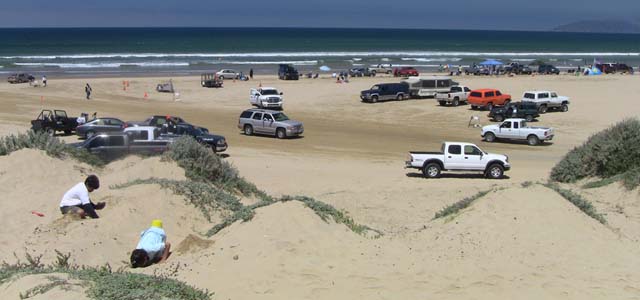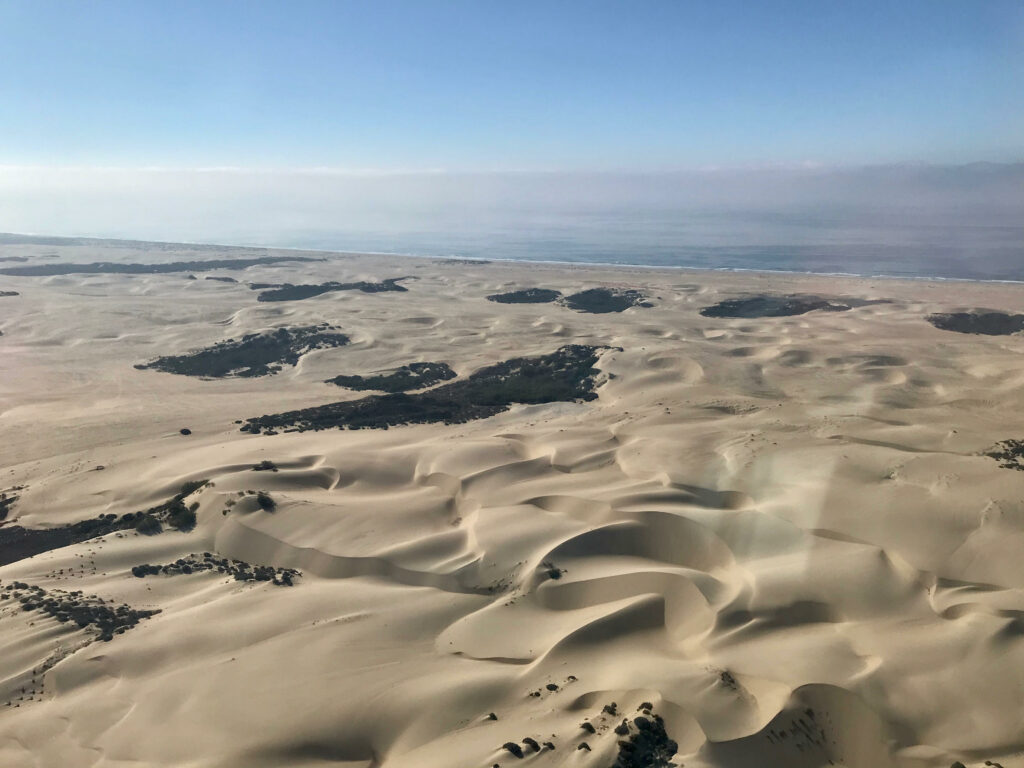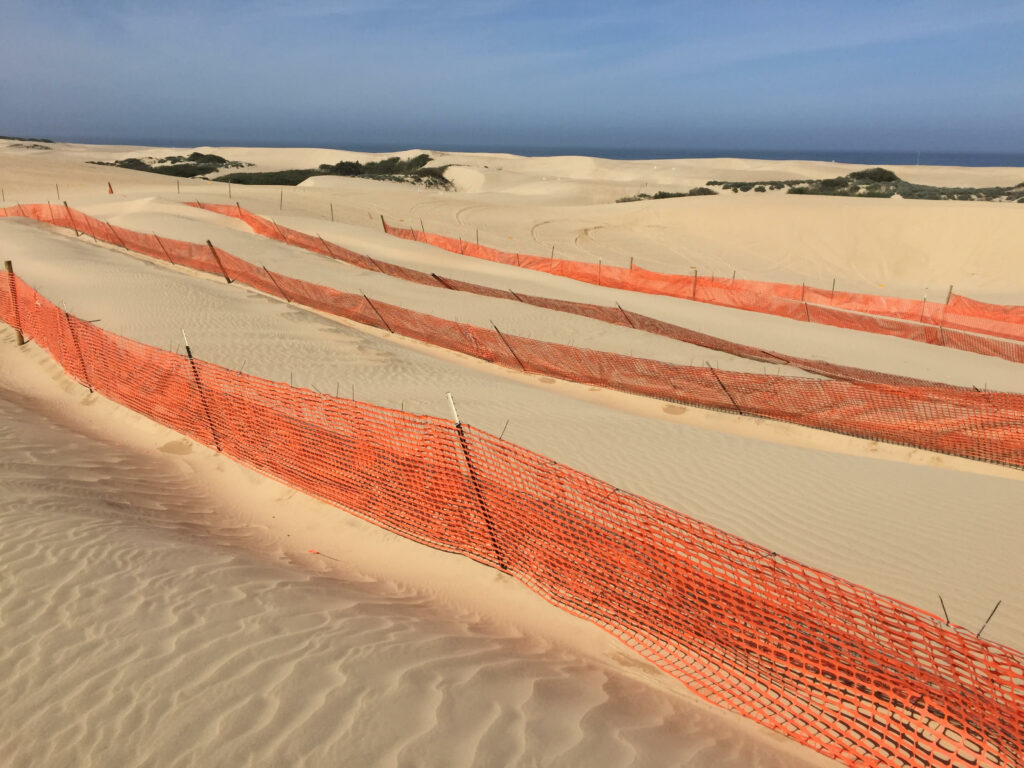California employee reports misspending and malfeasance at Oceano Dunes
January 24, 2023

By KAREN VELIE
A geologist working for the California Geological Survey posted a critical assessment of alleged misspending and malfeasance by a San Luis Obispo County agency and of state officials who have ignored their own findings at a cost of more than $20 million.
For more than a decade, Will Harris worked as a senior engineering geologist for state parks investigating a dust rule that concluded off-road activity on the dunes had caused an increase in pollution on the Nipomo Mesa. The SLO County Air Pollution Control District’s contested study is the catalyst for the spending of approxamtly $23 million for mitigation efforts.
In an attempt to inform the APCD of the flawed information from a study that was the basis for the dust rule, Harris spoke during public comment at an APCD board meeting in 2015, in which he argued the district’s Oceano Dunes dust rule was flawed.
During the meeting, then county Supervisor Adam Hill threatened Harris’ job. Three days later, Supervisor Bruce Gibson followed up the threat in a letter to California’s chief geologist, which led the state to temporarily reassign Harris.
Nevertheless, a recently peer-reviewed report by the Scripps Institution of Oceanography appears to exonerate Harris.
Harris’ post on Facebook in its entirety, notes mentioned are available in the comments under the post
An investigation by the Scripps Institution of Oceanography indicates that particulate pollution detected downwind of Oceano Dunes contains 14% dust and that the amount of dust attributable to off-highway vehicle recreation in the dunes is “some portion of that 14%.” The report states that regulatory efforts to reduce downwind PM10 “by reducing dunes area and limiting vehicle access appears to constitute a misapplication of PM regulations given the small fraction of PM for which dust accounts.”
California State Parks has spent in excess of $22 million to adhere to the “PM regulations,” with expenditures ongoing.
The Scripps work is published in the Feb. 1, 2023 edition of the scientific journal Atmospheric Environment and can be accessed via this link.
The information below is provided to put the significance on the Scripps findings into context
The park lies within the 18,000 acre Guadalupe-Nipomo Dunes Complex, which stretches from Pismo Beach to dunes south of the Santa Maria River mouth.
Sand dunes have formed here for hundreds of thousands of years thanks to three ingredients:
1. Lots of sand that is essentially stockpiled offshore—sand provided by local streams and rivers and the longshore current.
2. Strong prevailing winds blowing onshore from the west and northwest; these winds blow predominantly in the spring and to a lesser extent in the fall.
3. A low-lying, west-facing shoreline that is a catcher’s mitt of sorts, receiving the brunt of the prevailing winds.
Tides and surf bring the sand to shore, and there the wind takes over, pushing the sand up the beach, causing the grains to creep and bounce downwind in a process called saltation. Saltation sorts the sand into layers, one layer on top of the other, and as those layers build they form the dunes and allow the dunes to migrate downwind.
The sand layers are ephemeral, obliterating whenever the wind shifts, or when the dunes are stepped on or driven over. The layers form again when the wind blows strongly enough to initiate the saltation process—a given in this setting.
Nipomo Mesa (Mesa) is a semi-rural region of south San Luis Obispo County that is a mile or so downwind, or easterly of Oceano Dunes. Since 2010, the local air district (the San Luis Obispo County Air Pollution Control District or SLOAPCD) has blamed OHV recreation at the state park for elevated concentrations of particulate pollution, or PM10, detected on the Mesa. Mostly in the spring, when the prevailing winds are strongest, the SLOAPCD monitoring stations on the Mesa record particulate concentrations that exceed the state’s air quality standard for PM10.
Since 2011, the SLOAPCD has attempted to regulate and fine State Parks for the PM10 exceedances. In 2018, it imposed a stipulated order of abatement (SOA) against State Parks, which effectively required Parks to eliminate ongoing violations of the state’s PM10 standard on the Mesa.
Over the years, the air district has given varying reasons as to why State Parks should be held to account, and to one extent or another those reasons all regard the prevailing wind and saltation of dune sand within the OHV riding area of the park.
Their initial reasons also attempted to directly associate OHV recreation with the PM10. They said there was a crust on the dunes, similar to the high desert playa Owens Lake, and that vehicles destroy the crust, allowing sand particles beneath the crust to be lofted by the wind. And they claimed to identify a statistical correlation between OHV recreational activity and elevated PM10 concentrations downwind on the Mesa.
Both of these reasons were disproven, and the air district no longer mentions them (see Note #1).

The air district also reasoned incorrectly that because the sand grains are mostly composed of the silica mineral quartz (the grains are actually mostly feldspar), the dust from saltation must also contain silica, and so they warned the community and agencies such as the California Coastal Commission about a perceived acute health risk associated with silica dust in the PM10.
But the SLOAPCD never tested the PM10 for silica content before making those claims. Analysis of the PM10 conducted by a State Parks contractor years later revealed that there was “no evidence of a realistic pulmonary inhalation risk with respect to crystalline silica.” Once the results of the testing were out, the air district deemed the issue of silica dust in the PM10 “a red herring” (see Note #2).
Next it was “hot spots” of dust emission from the dunes, that is, saltation occurred more readily—at lower wind speeds—where OHV recreation was more intensive. This too was abandoned because identifying those hot spots via measurements of dust emissivity on dune surfaces proved elusive.
Finally, by 2020, it was just saltation generally in the OHV riding area of the dunes that was causing the high PM10 according to the air district. But discerning the difference, or “delta,” in the sand’s ability to emit dust via saltation from the dunes inside the OHV riding area versus outside the riding area was still elusive.
Experts working with the SLOAPCD and State Parks as part of the SOA process examined years’ worth of dust emission data they had collected in the dunes, and eventually, through statistical analysis, they determined different dust emission values for the dunes both inside and outside the riding area—the “delta.” That difference indicated saltation-generated dust emissions from the riding area were higher than outside the riding area.
Then the experts populated computer models with the “delta” data to determine how much saltation dust emits from the OHV riding area of the dunes and to where it disperses.
The computer modeling has also been used to estimate the dust-reduction effectiveness of “mitigations” placed in the dunes—mitigations consisting of fencing or plots of vegetation placed in the OHV riding area of the dunes that hamper the saltation process by reducing the wind speed along the dune surface. The mitigations have been deemed necessary by the air district to meet the obligations of the SOA.

Oceano Dunes dust mitigation fencing
Fencing and vegetation projects mandated by the SOA have thus far reduced the OHV riding and camping areas to approximately 900 acres. Prior to the SOA, approximately 1,500 acres was open to riding and camping. As of August 2021, State Parks spent more than $22 million on these mitigations and related SOA expenses, including nearly $3 million for the most recent year on record (see Note #3). And the expenditures continue.
Despite these efforts, the number of violations of the state’s PM10 standard has only increased. Last year, for the months April, May, and June, which are the windiest months in any given year, there were 40 violations of the PM10 standard. That number of violations is more than any of the previous 8 years for the same three-month timeframe (see Note #4).
A key term that the SLOAPCD and its SOA experts have used synonymously with the Mesa PM10 is “dust.” The mitigations, the computer modeling, the air district’s basic premise that the high PM10 on the Mesa is from the OHV riding area of the dunes, all assume that the PM10 on the Mesa is from dust generated by the saltation process in the dunes.
Saltation does indeed generate dust: As the wind pushes the sand, sand grains bounce along the dune surface, and in so doing they dislodge other grains, including finer grains that can be considered dust. The finer particles are lofted by the wind, sometimes settling out downwind, sometimes becoming entrained in the wind.
But PM10 and dust from sand saltation are not synonymous. PM10 is a generic term referring to any airborne particle of a certain size and smaller. Instruments used to measure PM10 detect dust, smoke, aerosols, water vapor, even sea salt in the air, as the same generic thing: particles suspended in a volume of air.
The dust from the saltation of dune sand has the same mineral composition as the dune sand because the dust particles are just smaller bits of that sand. The amount of mineral dust within a sample of PM10 can be determined by using gravimetry and speciation. Gravimetric analysis determines the weight of PM10 and is conducted by weighing the amount of PM10 collected from a known volume of air on a pre-weighed air filter and subtracting the weight of the air filter. Speciation follows, where the PM10 on the filter is analyzed to determine its proportional mass of oxidized elements.
Most elements oxidize, that is, bond with oxygen, and oxidized elements are associated with minerals, particularly minerals from the earth’s crust. Broadly speaking, specific oxidized elements identified together in speciation analysis define the mineral dust content of a PM10 sample, and the combined oxidized mass of those elements define the weight of the mineral dust in the sample.
Despite the air district’s assumption that the PM10 on the Mesa is from dust in the dunes, despite SOA-mandated mitigations placed in the dunes that will only reduce dust from sand saltation, and despite the computer modeling used by the SOA experts that assumes 100% of the PM10 on the Mesa is mineral dust, neither the air district nor the SOA experts have determined how much dust is in the Mesa PM10.
Scripps Institution of Oceanography investigates dust on the Mesa
But Dr. Lynn Russell from Scripps did. Dr. Russell is an atmospheric chemist, and due to her relevant experience, she was contracted by State Parks to determine the dust content of the Mesa PM10.
As mentioned, the prevailing winds along this stretch of coast are strongest in the spring, and typically, during each spring day, the winds rise to greatest on-shore strength from early afternoon to early evening. This is also when the SLOAPCD’s automated hourly measurements of Mesa PM10 are their highest.
As part of her three-year investigation, which began in 2019, Dr. Russell targeted the high wind/high PM10 seasons, sampling the Mesa air for PM10 from late morning to early evening to ensure the PM10 concentrations would be at their greatest, and presumably, when the amount of dust in the PM10 would also be greatest.
What Dr. Russell discovered was that the amount of dust in the PM10 was 14%, meaning the amount of dust that could be attributed to dust from the OHV riding area of Oceano Dunes would be “some portion of that 14%.”
The implications of the findings are significant. It would appear that all computer modeling, which assumes the PM10 is 100% mineral dust, is invalidated; that mitigations placed in the dunes to stop dune saltation do little to nothing to reduce PM10 on the Mesa; and that the air district’s basic premise to impose an SOA against State Parks for causing high PM10 on the Mesa is without foundation. Or, in the words of Dr. Russell, “The reduction of dune dust by reducing dunes area and limiting vehicle access appears to constitute a misapplication of PM regulations given the small fraction of PM for which dust accounts.”
First season findings of the Scripps work were presented to State Parks in a report dated Fe. 21, 2020. Dr. Russell presented second season findings at the Sept. 24, 2020 meeting of the state’s Off Highway Motor Vehicle Recreation Commission, as well as in a written report to State Parks and the Commission dated the same day.
She submitted a report of third season findings to State Parks on Nov. 8, 2021 and presented those findings to the OHMVR Commission on Dec. 9, 2021. The final report of the Scripps investigation is dated Feb. 24, 2022 and was submitted to State Parks on that day.
With increasing documented certainty, each report and presentation indicated that dust was but a small fraction of the Mesa PM10. Despite this, State Parks continued to meet the obligations of the SOA without objection, and the SLOAPCD and the SOA experts refused to acknowledge the 14% dust findings, or at least present evidence to the contrary.
State Parks and the air district both indicated that “peer review” of Dr. Russell’s work needed to be conducted to add merit and garner consideration. The link at the top of this passage is to the peer-reviewed article.
Dr. Russell and her former PhD student, Dr. Savannah Lewis, published their work, entitled, “Small Contributions of Dust to PM2.5 and PM10 Concentrations Measured Downwind of Oceano Dunes,” in the Feb. 1, 2023 issue of the scientific journal Atmospheric Environment.
The online version of this article was available in late November 2022. State Parks was informed of this and given a copy of the published piece on Nov. 24, 2022.
It is unclear if State Parks told OHMVR commissioners that peer-reviewed publication of Dr. Russell’s work had occurred. Neither State Parks nor the OHMVR Commission have provided public acknowledgement of the publication.
The OHMVR Commission will hold a meeting regarding Oceano Dunes on Jan. 24, 2023. The posted agenda for that meeting does not mention Dr. Russell nor the publication of the Scripps work (see Note #5), so it would seem the Commissioners have not been updated.






The comments below represent the opinion of the writer and do not represent the views or policies of CalCoastNews.com. Please address the Policies, events and arguments, not the person. Constructive debate is good; mockery, taunting, and name calling is not. Comment Guidelines